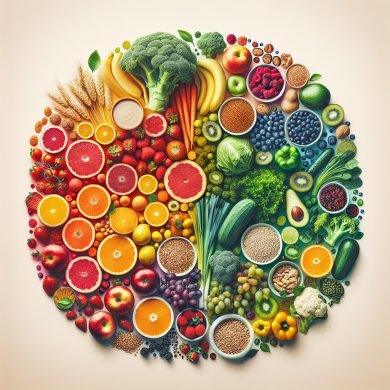Master Clean Eating: Slash Sugar Intake Effectively
Introduction
In today’s fast-paced world, maintaining a healthy diet can be challenging. Many people consume far more sugar than they realize, as it’s hidden in countless foods and beverages. The overconsumption of sugar is linked to various health issues, including obesity, diabetes, and heart disease. Mastering clean eating by reducing sugar intake is crucial for those seeking a healthier lifestyle. This article will guide you through understanding sugar’s role in your diet and offer practical steps to slash your sugar intake effectively.
Understanding Sugar and Its Impact
What is Sugar?
Sugar is a type of carbohydrate that provides energy to the body. It is found naturally in fruits, vegetables, and dairy products, but it’s also added to many processed foods. The two main types of sugars are naturally occurring sugars and added sugars. While naturally occurring sugars are part of whole foods and come with fiber and nutrients, added sugars contribute empty calories with no nutritional benefits.
Health Risks of Excessive Sugar Consumption
Consuming excessive amounts of sugar can lead to numerous health problems. It can increase the risk of obesity by adding unnecessary calories to your diet. Moreover, high sugar intake is linked to insulin resistance, which can lead to type 2 diabetes. It also contributes to heart disease by increasing blood pressure and inflammation. Additionally, sugar is detrimental to dental health, as it fuels bacteria in the mouth, leading to cavities.
The Benefits of Reducing Sugar Intake
Cutting down on sugar offers a myriad of health benefits. Lower sugar consumption can stabilize energy levels, improve mood, and enhance mental clarity. It can also promote weight loss and reduce the risk of developing chronic diseases. By focusing on clean eating, you can ensure that you’re obtaining necessary nutrients, leading to overall better health and well-being.
Practical Steps to Slash Sugar Intake
Read Food Labels Carefully
One of the most effective ways to reduce sugar intake is by becoming vigilant about reading food labels. Look for terms like high fructose corn syrup, sucrose, glucose, and other ingredients that end in “-ose.” Many foods that seem healthy, such as yogurt and granola bars, often contain added sugars. Prioritize products that have low or no added sugars.
Choose Whole Foods
Emphasize whole foods in your diet, such as fruits, vegetables, whole grains, lean proteins, and healthy fats. These foods are packed with essential nutrients and fiber, helping to keep you full and satisfied. When you consume whole foods, you naturally reduce the intake of processed foods that often contain hidden sugars.
Curb Sweet Cravings
Managing cravings is crucial when trying to reduce sugar intake. Opt for naturally sweet options like fruits instead of sugary snacks. Incorporate protein and healthy fats into your meals, as they help stabilize blood sugar levels and reduce cravings. Drinking water and staying hydrated can also help curb sugar cravings.
Limit Sugary Beverages
Sugary drinks are one of the most significant sources of added sugar in the diet. Sodas, energy drinks, and sweetened coffees and teas can significantly increase calorie intake without providing any nutritional benefits. Replace these beverages with water, herbal teas, or unsweetened drinks. Adding slices of lemon, cucumber, or berries to water can make it more appealing.
Cook More at Home
Preparing meals at home allows you to have complete control over the ingredients you use. Cooking from scratch helps you avoid the hidden sugars often found in restaurant and takeout foods. Experiment with herbs and spices to add flavor without needing to rely on sugar.
Be Mindful of Portion Sizes
If you consume foods with natural sugars, such as fruits and dairy, be mindful of portion sizes. While these foods are nutritious, eating them in large quantities can still lead to excessive sugar intake. Balance your diet by including a variety of foods from all food groups.
Substitutes for Sugar
Natural Sweeteners
Natural sweeteners like honey, maple syrup, and agave nectar can be used as alternatives to refined sugar. While they are less processed, they should still be used in moderation as they contain similar calorie content. Stevia and monk fruit are other natural options that provide sweetness without calories.
Artificial Sweeteners
Artificial sweeteners, such as aspartame, sucralose, and saccharin, offer sweetness without the calories. However, they may not be suitable for everyone and can have varying taste profiles. It’s essential to research and choose an option that suits your taste and dietary needs.
Overcoming Challenges
Dealing with Sugar Withdrawal
Reducing sugar intake might lead to withdrawal symptoms, including headaches, irritability, and fatigue. These symptoms are temporary and usually subside within a few days. Staying hydrated, getting enough sleep, and eating balanced meals can help ease the transition.
Maintaining Motivation
Staying motivated is crucial when making dietary changes. Set realistic goals and track your progress. Celebrate small victories and remind yourself of the long-term health benefits. Seeking support from friends, family, or online communities can also provide encouragement and accountability.
Conclusion
Mastering clean eating by effectively slashing sugar intake is a vital step towards better health. By understanding the impact of sugar on your body and implementing practical strategies, you can reduce your sugar consumption and enjoy a healthier lifestyle. Embrace whole foods, read labels carefully, and be mindful of portion sizes to make informed choices. Remember, the journey to reducing sugar intake is a gradual process, but the benefits are well worth the effort. Start today and experience the positive impact of a low-sugar diet on your overall well-being.















Add comment